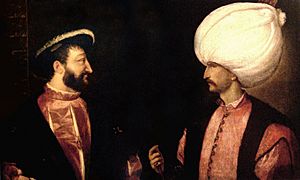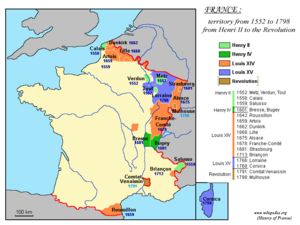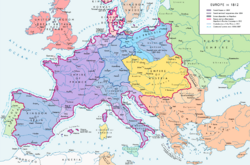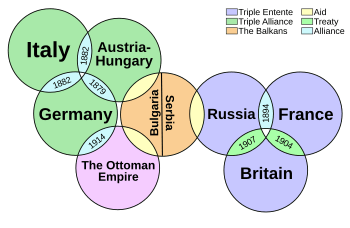History of French foreign relations facts for kids
The history of France's relationships with other countries goes back a long way, showing how France worked with or against other nations. This story covers French diplomacy and foreign relations up to 1981. For more recent events, you can look at the foreign relations of France.
Contents
France's Early Years: 1453–1789
The Franco-Ottoman Alliance
Imagine a time when Christian and Muslim countries usually fought. But in 1536, something surprising happened! King Francis I of France and Sultan Suleiman the Magnificent of the Ottoman Empire formed a military alliance. This was a big deal because it was the first alliance between a Christian and a Muslim state.
This alliance helped France fight against the powerful Holy Roman Empire. It was especially important during the Italian Wars. The alliance lasted for over 250 years, until Napoleon's invasion of Egypt in 1798. People at the time were shocked by this "sacred union" between the French "lily" and the Ottoman "crescent moon."
Kings Louis XIV and Louis XV
Under the long reigns of King Louis XIV (1643–1715) and King Louis XV (1715–1774), France was a very strong country. It was second in size only to Russia but had the most economic and military power in Europe.
Louis XIV loved war and saw it as a way to gain glory for France. He wanted to stop the Habsburg family, who controlled Austria and Spain, from becoming too powerful. He had great military leaders and a finance minister, Jean-Baptiste Colbert, who helped pay for his large army. France fought three major wars under Louis XIV: the Franco-Dutch War, the War of the League of Augsburg, and the War of the Spanish Succession.
Louis XV added Lorraine and Corsica to France. However, France lost badly in the Seven Years' War (1754–1763). It had to give up its lands in North America, including New France to Britain and Louisiana to Spain. This made France very angry and eager for revenge.
Helping America in the Revolutionary War
France got its chance for revenge in the American Revolutionary War (1775–1783). France secretly sent supplies to the American Patriots who were fighting Britain. When the Americans won a big battle at Saratoga in 1777, France officially recognized the United States.
In 1778, France signed a military alliance with the U.S. and went to war with Britain. France also formed alliances with the Netherlands and Spain. They sent money, weapons, and even an army to help George Washington. The French navy played a key role in stopping the British army at Yorktown in 1781, which led to the American victory.
This war was very expensive for France. The huge debt it created helped cause the French Revolution in 1789. So, while France got its revenge, it also faced serious problems at home. Benjamin Franklin, the American ambassador to France, became a hero there. He was seen as a symbol of the new American spirit.
Revolution and Napoleon: 1789–1815
The French Revolution
After the French Revolution began, the new government in Paris became very radical. They even executed King Louis XVI. Other European countries, like Austria, Prussia, Britain, and Spain, formed a military group called the First Coalition (1792–97). They wanted to stop the revolution from spreading.
France responded with "total war" and a "mass conscription" (meaning everyone had to join the army). A young general named Napoleon became famous for his victories. France occupied Belgium and the Rhineland, and even set up a friendly government in the Netherlands. In 1795, France made peace with Spain and Prussia.
The Napoleonic Wars
By 1799, Napoleon had taken control of France. He was a brilliant military leader and good at forming alliances. Britain led several groups of countries to fight against him. In 1806, Prussia joined Britain and Russia, forming the Fourth Coalition.
Napoleon's army crushed Prussia and defeated Russia in 1807. He forced Russia to join his "Continental System," which aimed to block trade with Britain. He also took half of Prussia's lands.
Napoleon then turned his attention to Britain. He invaded Portugal and Spain, putting his brother, Joseph Bonaparte, on the Spanish throne. But the Spanish and Portuguese fought back using guerrilla tactics, which are small, surprise attacks. British forces also helped them.
In 1808, Austria formed the Fifth Coalition to fight Napoleon. Austria won one battle but was eventually defeated. Napoleon's empire seemed unbeatable, but this changed in 1812.
Napoleon decided to invade Russia with a huge army. It was a terrible disaster, mainly because of the harsh weather, disease, and lack of supplies. Only a small part of his army returned. At the same time, French armies were defeated in Spain.
With France weakened, other countries formed the Sixth Coalition. German states turned against Napoleon. He was finally defeated at the Battle of Leipzig in 1813. The Allies invaded France, and Napoleon gave up his power in 1814. The old kings were put back in charge of Europe. Napoleon tried to return to power for 100 days, but he was finally defeated at the Battle of Waterloo in 1815.
France: 1815–1852
After Napoleon, France was no longer the most powerful country. But it was still important in Europe's economy, culture, and diplomacy. The old royal family, the Bourbons, were put back on the throne. But they were overthrown in 1830 and again in 1848. Then, Napoleon's nephew, Napoleon III, became president and later emperor. He pursued an aggressive foreign policy.
France also started building a new overseas empire, especially in Africa and Indochina. The French economy was strong, and Paris became a major center for international finance, like London.
Building an Empire in the 1800s
France began to rebuild its worldwide empire after 1850. They focused on North and West Africa, and Southeast Asia. They also gained lands in Central and East Africa, and the South Pacific.
French leaders believed they had a "civilizing mission." This meant they thought it was their duty to bring Christianity and French culture to other parts of the world. For example, in 1884, Jules Ferry, a leading supporter of colonialism, said that "the higher races have a right over the lower races, they have a duty to civilize the inferior races."
France sent only a small number of settlers to its colonies, except for Algeria. In Algeria, French settlers held power but were still a minority. The empire brought prestige to France and provided raw materials and markets for French goods. It also supplied soldiers during the World Wars.
Second Empire: 1852–1871
Napoleon III wanted to achieve glory in foreign affairs, just like his famous uncle. But he often made mistakes as a diplomat. He did strengthen French control in Algeria, set up bases in Africa, and began taking over Indochina. He also helped a French company build the Suez Canal.
However, in Europe, Napoleon III often failed. The Crimean War (1854–1856) against Russia cost many lives and a lot of money, but France gained nothing. A war with Austria in 1859 helped unify Italy, and France gained Savoy and Nice. But Napoleon angered many countries and groups, including Catholics and liberals.
Finally, Napoleon III was outsmarted by the Prussian leader Otto von Bismarck. France went to war with Germany in 1870. France had no allies and was badly defeated, losing the regions of Alsace and Lorraine. This defeat greatly weakened France as a major power.
American Civil War and Mexico
During the American Civil War (1861–1865), France officially stayed neutral. But Emperor Napoleon III had plans for Mexico. He hoped a Confederate victory would create two weak nations on Mexico's border, allowing France to control Mexico.
In 1861, France invaded Mexico and installed an Austrian prince, Maximilian I of Mexico, as its puppet ruler in 1864. The United States, busy with its own Civil War, warned France not to interfere in Mexico.
Once the Union won the Civil War in 1865, the U.S. strongly protested France's actions. Washington sent General William Tecumseh Sherman with 50,000 soldiers to the Mexican border. Napoleon III had no choice but to pull his army out of Mexico. Emperor Maximilian was executed by the Mexican government in 1867. This whole adventure was a big disaster for France.
Third Republic: 1871–1914
After losing to Germany in 1871, France's foreign policy was largely driven by a strong desire for revenge and to get back Alsace and Lorraine. French diplomats, especially at the Quai d'Orsay (the Foreign Ministry), were very professional. They often guided foreign policy because politicians were busy with problems at home.
Most diplomats came from wealthy families. Even though France was a republic, its diplomats fit in well with the royal courts of Europe. There was a general agreement on the need for high tariffs to protect French agriculture. The French colonial empire was also a source of great pride.
Colonial Empire in Africa and Asia
During the "Scramble for Africa" in the late 1800s, France greatly expanded its colonial empire. Catholic missionaries played a big role. France acquired French Indochina, Madagascar, huge territories in French West Africa and French Equatorial Africa, and much of French Polynesia.
The Suez Canal, built by the French, became a joint British-French project in 1875. Both countries saw it as vital for their empires in Asia. In 1881, France occupied Tunisia. In 1884, they occupied Guinea.
Fashoda Crisis with Britain in 1898
There were serious tensions between France and Britain over African territory. The most dangerous moment was the Fashoda Incident in 1898. French troops tried to claim an area in southern Sudan, but a stronger British force arrived. Under pressure, the French withdrew. This was a public humiliation for France. It led to an agreement where Britain controlled Egypt, and France became the main power in Morocco.
Asia
France also had colonies in Asia. They looked for allies and found one in Japan. France sent military missions to Japan to help modernize the Japanese army. Conflicts with China over Indochina led to the Sino-French War (1884–1885). France won, gaining control over northern and central Vietnam.
Franco-Russian Alliance
France felt isolated after Germany's rise. Germany's leader, Bismarck, had successfully kept France alone. But when Kaiser Wilhelm removed Bismarck in 1890, the situation changed. Russia, which had been allied with Germany, was now alone.
Both France and Russia needed a military alliance to counter Germany's growing power. French banks eagerly lent money to Russia, for example, to build the Trans-Siberian railway. By 1895, France and Russia signed the Franco-Russian Alliance. This was a strong military agreement to help each other if Germany attacked. France had finally escaped its diplomatic isolation.
1900–1914
After Bismarck left office in 1890, France's efforts to isolate Germany finally worked. France's foreign minister, Théophile Delcassé, worked hard to win over Russia and Great Britain. Key steps were the Franco-Russian Alliance of 1894, the 1904 Entente Cordiale with Britain, and the Anglo-Russian Entente in 1907. These three agreements formed the Triple Entente.
By 1914, French foreign policy was based on its alliance with Russia and an understanding with Britain. They all saw Germany as the main threat. When Germany mobilized its forces in response to Russia, France also had to mobilize. Germany then invaded Belgium and France, and World War I began.
First World War
Germany declared war on France on August 3, 1914. Germany invaded Belgium and northeastern France, hoping for a quick victory. But their plan failed due to Belgian resistance and poor coordination. France defended Paris in the First Battle of the Marne, pushing the German armies back.
The war then became a stalemate on the Western Front. Both sides dug trenches, and there was little movement until 1918. Battles caused huge numbers of casualties due to machine guns, heavy artillery, and poison gas. The rich industrial areas of Belgium and northeastern France remained under German control.
French leaders called for a "Sacred Union," meaning everyone should unite for the war effort. Most French people supported the war. However, by 1917, people were tired of the war, and even the army felt it.
In 1917, the Russian Revolution ended the Franco-Russian alliance. France then joined Britain in sending forces against the Bolsheviks (Communists) in Russia. France also supported the independence of countries like Poland and Czechoslovakia. Serbia was a loyal ally of France throughout the war.
Paris Peace Conference 1919
France suffered heavy losses in the war, both in lives and economically. But it was on the winning side. At the Paris Peace Conference in 1919, France wanted revenge against Germany. Prime Minister Georges Clemenceau pushed for harsh terms.
The Treaty of Versailles was forced upon Germany, which deeply resented its strict rules. France also strongly supported the new Kingdom of Serbs, Croats, and Slovenes (later Yugoslavia). This country helped France by opposing German ambitions in the Balkans in the 1920s and 1930s.
Between the World Wars
After 1919, France's foreign policy aimed to weaken Germany and make sure it followed the Treaty of Versailles. France tried to form alliances against Germany, but it was hard to get strong support from Britain or the United States.
The 1920s
In January 1923, France and Belgium occupied the industrial region of the Ruhr in Germany. This was because Germany failed to send enough coal as part of its war payments. Germany responded by printing more money, which caused hyperinflation (money losing its value very quickly). This hurt the German middle class and also the French economy. The occupation was not successful.
In 1924, France accepted the Dawes Plan, an international effort to help Germany with its war payments. This plan also ended the occupation of the Ruhr. The Locarno Treaties of 1925 helped bring Germany back into good relations with France. These treaties guaranteed the border between France and Germany.
In the 1920s, France built the Maginot Line, a strong system of border defenses. It was designed to stop any German attack. However, the Maginot Line did not extend into Belgium, which is where Germany attacked in 1940. France also signed military alliances with smaller countries in Eastern Europe, called the "Little Entente."
The 1930s

In the 1930s, France became a very cautious country. Its economy was struggling, and there were many political disagreements. This led to a lack of strong direction in foreign policy.
Pierre Laval, who was prime minister and foreign minister from 1934 to 1936, deeply distrusted Nazi Germany. He tried to form alliances against Germany. He signed agreements with Italy and the Soviet Union, but these alliances were not fully put into action.
As Germany grew stronger under Hitler, France increasingly adopted a policy of "Appeasement." This meant trying to keep peace by giving in to some of Hitler's demands. When Hitler sent troops into the Rhineland in 1936 (an area where no troops were allowed), neither France nor Britain risked war. This showed other European countries that France might not stand up to Germany.
France's military strategy was entirely defensive. It planned to defend the Maginot Line but had no intention of invading Germany. This made potential allies in Eastern Europe lose trust in France. Belgium even dropped its alliance with France and chose to be neutral.
In 1938, Prime Minister Édouard Daladier refused to go to war against Germany and Italy without British support. He agreed to the Munich Agreement in 1938, which allowed Germany to take part of Czechoslovakia. This was a betrayal of France's alliance with Czechoslovakia.
The left-wing government of Léon Blum (1936–37) joined Britain in stopping arms sales during the Spanish Civil War. Blum feared that civil war might spread to France. However, he secretly supplied warplanes and money to the Spanish Republicans. The government also increased its efforts to rearm the French military.
Second World War
Entering the War
In 1938, Germany demanded control of the German-speaking Sudetenland in Czechoslovakia. Czechoslovakia had a defense alliance with France, but its military position was hopeless. At the Munich conference in September 1938, leaders from Germany, Italy, Britain, and France met. The British and French wanted peace and time to catch up to Germany's military strength.
After the conference, Hitler got his way, and Germany peacefully took over the Sudetenland. In March 1939, Germany took over the rest of Czechoslovakia. Britain and France finally realized that appeasement was not working.
In spring 1939, Hitler made demands on Poland. This time, Britain and France announced they would go to war to defend Poland. Efforts to get the Soviet Union to join them failed. Instead, the Soviet Union made a deal with Hitler to divide up Poland. Hitler invaded Poland on September 1, 1939. Britain and France declared war on September 3, 1939. But they could do little to help Poland.
German Conquest in 1940
France and Britain declared war on Germany two days after Germany invaded Poland. For several months, there was little fighting, known as the "Phoney War." Britain tried to make peace, but Hitler did not respond.
In spring 1940, Germany launched its "Blitzkrieg" (lightning war) against Denmark and Norway. Then, it invaded the Netherlands and Belgium. Britain and France sent their best troops into the Netherlands, where they became trapped in the Battle of France in May 1940. The Royal Navy rescued over 300,000 British and French soldiers from Dunkirk, but they had to leave all their equipment behind.
Paris fell to the Germans on June 14, 1940. The French government surrendered on June 24, 1940. Nazi Germany occupied three-fifths of France. The rest of the country was left to the new Vichy government, which was somewhat controlled by Germany. Nearly 2 million French soldiers became prisoners of war in Germany.
Vichy France
After France fell in June 1940, a new government called Vichy France was formed. It was officially neutral but was controlled by Germany until November 1942. Vichy was very conservative and anti-Communist, but it was largely helpless because Germany controlled so much of France and held many French prisoners. Vichy finally collapsed in 1944 when the Germans retreated.
The United States recognized Vichy France and hoped to encourage elements in the government that opposed working with Germany. Washington wanted France to avoid any actions that could hurt the Allied war effort. When Germany took full control of France, the U.S. and Canada cut ties with Vichy.
The French Fleet
Britain worried that the French navy might fall into German hands. Under the armistice, France was allowed to keep its navy, but Vichy refused to send it to Britain or other French territories far from Germany. So, Britain attacked a large French naval group at Mers-el-Kebir, killing many French sailors. Vichy broke off diplomatic relations but did not declare war on Britain.
North Africa
In late 1942, the U.S. prepared to land in North Africa. They looked for a French ally there. They found Admiral François Darlan, a Vichy leader, who was captured and then supported the Americans. The Allies, led by General Dwight D. Eisenhower, made a deal with Darlan. This shocked many, as Darlan had been working with the Nazis. But Roosevelt and Churchill supported Eisenhower's plan. Darlan was assassinated in December 1942.
Free France
Free France was the French government in exile, based in London. It was led by General Charles de Gaulle. He was the highest-ranking French officer to refuse the surrender in June 1940. He urged patriotic French people to resist Nazi Germany. He formed the Free French Forces from soldiers who had escaped to Britain.
With British support, the Free French gradually gained control of all French colonies except Indochina, which Japan controlled. De Gaulle often created diplomatic problems for the U.S. and Britain because he insisted that France be treated as a great power and that he was its only true representative.
When the British and Americans landed in France in June 1944 (D-Day), de Gaulle refused to allow French soldiers to land. However, the U.S. and Britain allowed de Gaulle the honor of being the first to march into Paris at the head of his army after the Germans fled.
De Gaulle emphasized that Free France supported the Soviet Union, as Communists played a big role in the French Resistance. However, the major Allied powers (U.S., Britain, USSR) did not treat France as a major power. France was not invited to the important Yalta conference in February 1945, which was humiliating.
Fourth Republic: 1944–1958
The Popular Republican Movement (MRP), a moderate party, largely controlled French foreign and colonial policies in the late 1940s and 1950s. It strongly supported European integration, NATO, and a close alliance with the United States. MRP leaders were key in France's tough colonial policies, which led to long wars in Vietnam (1946–1954) and Algeria (1954–1962).
France was upset when the U.S. and Britain refused to share atomic secrets. So, France developed its own nuclear weapons. Britain did ensure that France was included in the division of conquered Germany into zones (Soviet, British, American, and French). In 1949, the U.S., Britain, and France helped establish West Germany.
The Cold War began in 1947. Despite having a large pro-Soviet Communist Party, France joined the Western Allies. The first step was the Dunkirk Treaty with Britain in March 1947.
The Marshall Plan (1948–1951) was an American program to help rebuild Europe. The U.S. gave $17 billion in aid. France received $2.3 billion, which helped it buy food and machinery from the U.S. The Marshall Plan also encouraged European countries to work together and adopt modern business practices.
In April 1949, France, the U.S., Britain, Canada, and eight other Western European countries signed the North Atlantic Treaty, creating NATO.
Indochina War (1946–1954)
The First Indochina War began in French Indochina in December 1946. It was a fight between French forces and the Communist Việt Minh, led by Ho Chi Minh. Most of the fighting happened in northern Vietnam.
After Japan surrendered in 1945, Ho Chi Minh declared the independent Democratic Republic of Vietnam. But French forces soon took back control in the south. At first, it was a small-scale insurgency. But after Chinese Communists reached Vietnam's northern border in 1949, it became a full-scale war with modern weapons supplied by the U.S. (to France) and the Soviet Union (to Việt Minh).
French forces included troops from their colonies, French professional soldiers, and the French Foreign Legion. The war became very unpopular in France, where it was called the "dirty war."
The French suffered a decisive defeat at the Battle of Dien Bien Phu. At the Geneva Conference (1954) in July 1954, an agreement was made. It gave the Communists control of North Vietnam, and France pulled out all its forces. South Vietnam continued with strong American support. This conflict eventually led to the Vietnam War.
Pierre Mendès France, who was Prime Minister in 1954–55, made ending the Indochina War his top priority. He also began discussions for the independence of Tunisia and Morocco.
European Unification Begins
France was worried about a strong Germany again. But growing fear of the Soviets and the need for American aid led France to combine its occupation zone in Germany with the British and American zones, forming West Germany.
The idea of the European Coal and Steel Community (ECSC) was first proposed by French foreign minister Robert Schuman in 1950. It was a way to prevent future wars between France and Germany by sharing control of coal and steel production. The ECSC was formally established in 1951 by France, Italy, West Germany, Belgium, Luxembourg, and the Netherlands. This was a big step towards European unification.
Fifth Republic (1958 to 1981)
President de Gaulle, 1958–1969
In May 1958, a crisis in Algeria brought Charles de Gaulle back to power. He created the Fifth Republic with a stronger presidency. He managed to keep France united while granting independence to Algeria in 1962 and other French colonies.
De Gaulle believed France needed "grandeur" (greatness). He wanted France to be completely independent in world affairs. He twice blocked Britain from joining the Common Market, fearing it would overshadow France. He also pulled France out of NATO's military command, believing the U.S. had too much control. He started an independent nuclear weapons program, making France the fourth nuclear power.
He improved relations with West Germany to create a European balance between the American and Soviet influences. De Gaulle openly criticized the U.S. involvement in Vietnam. He also spoke out against American economic power. In Canada, he famously declared "Vive le Québec libre" ("Long live free Quebec"), supporting an independent Quebec. De Gaulle resigned in 1969.
President Georges Pompidou, 1969–1974
As president, Georges Pompidou was in charge of foreign policy. He tried to follow de Gaulle's policies but lacked his charisma. He worked to improve relations with North African and Middle Eastern countries. He continued de Gaulle's support for the Arab cause against Israel.
The United States wanted to improve relations with France after de Gaulle. President Richard Nixon and his advisor Henry Kissinger admired Pompidou. They agreed on most major policy issues. The U.S. even offered to help France's nuclear program.
Pompidou also did well in guiding the newly independent former French colonies in Africa. He visited several African nations, offering cooperation and financial help without the old colonial attitude.
President Valéry Giscard d'Estaing, 1974–1981
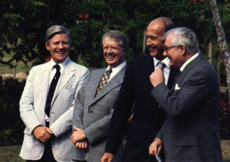
Valéry Giscard d'Estaing was a practical leader. In 1975, he invited leaders from West Germany, Italy, Japan, the United Kingdom, and the United States to form the Group of Six major economic powers (now the G7). He and West German Chancellor Helmut Schmidt launched the European Monetary System (EMS) in 1978 to support European economic unity.
In 1977, Giscard sent French fighter jets to Mauritania to fight against guerrillas. This was to support the Mauritanian leader, but it failed. In 1979, French troops helped remove Jean-Bédel Bokassa, a dictator in the Central African Republic, and restore the former president.
|
See also
- French colonial empire
- International relations of the Great Powers (1814–1919)
- Diplomatic history of World War I
- International relations (1919–1939)
- Military history of France
- Napoleonic Wars
- Paris Peace Conference, 1919
- Politics of France
- Territorial evolution of France
- Timeline of French history
- Austria–France relations
- Belgium–France relations
- Canada–France relations
- China–France relations
- Egypt–France relations
- France–Germany relations
- France–Italy relations
- France–Japan relations
- France–Netherlands relations
- France–Russia relations
- France–Serbia relations
- France–Spain relations
- France–Turkey relations
- France–Ukraine relations
- France–United Kingdom relations
- France–United States relations


